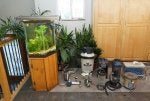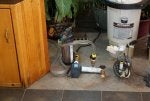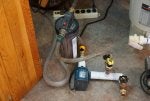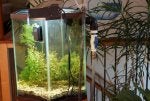Preface: I setup my first aquarium when I was about 12 yo using a broken tank from my middle school science teacher that I repaired myself. It was one of those great metal cornered tanks. From the very beginning I always wanted "More Filtration"! Fast forwards 30 years and several tanks someone gave me their old Vortex D1 DE filter. It turned my tank from a cloudy murky mess into a crystal clear beauty... I was hooked.
My first DIY DE filter: Unfortunately the Vortex D1 filter would clog after running it for about 5 days straight depending on water conditions and worst of all would suck down the electrons due to a very inefficient motor driving the pump. There had to be something better. After tons of reading and research I ended up with a Hayward EC40 DE pool filter (the big cylinder in the following picture).
![]()
In the front row with the black pond tubing wrapped around it is the original Vortex DE filter.
The Hayward DE filter was the best filter I have ever used. It kept my over stocked 110g cichlid perfect clear. It was pared with the trickle sump on the far right which gave gobs of biological filtration and kept the water full of oxygen. If anyone wants to build a sump I would highly recommend copying this simple effective sump design!
My 12 yo daughter has been bugging me for almost a year to setup a tank because she wants fishies! A couple weeks ago I brought the hex tank up from the storage room and set it up as a dirt under gravel planted tank. The initial fill went great but the water quickly turned brown with tannins. During our first water change we had a mishap and blasted the organic soil up through the gravel for a near water blackout! At that point I hauled the old Hayward EC40 DE filter upstairs and had the water crystal clear in about an hour. My love for DE filters was refreshed! BUT for some reason my daughter doesn't think a pool filter in the middle of our great room is appropriate... crazy kids! I relented and started planning a DE filter that would fit through the narrow 11" door on the stand and this is what I came up with...
DIY DE filter: Bigger than the Vortex but smaller than the pool filter I decided to use a whole house (Big Blue) cartridge filter I had lying around. I had a new 30 micron filter cartridge packed away with it so I decided to start there. The whole setup is very easy. Tank -> pump -> filter cartridge -> tank. Loading the cartridge is very easy, I just slowly dump pool filter diatomaceous earth directly into the intake in the tank. The pumps sucks the DE up with the water and quickly coats the filter cartridge.
![]()
![]()
Things I have learned over the years about 24x7 DE filters.
1) You really don't need a big pump. When I started with the EC40 I originally put an 1/4hp Little giant pump. Then I down sized to the 1/8hp Little Giant pump in the picture. Then I further downsized to the little QuietOne 3000 you see on my latest DIY filter. Even on the 110g tank the QuietOne 3000 pump was more than enough flow!
2) The Diatomaceous Earth lasts a LONG time! On my very dirty 110g cichlid tank I went 5 years, 24x7x365 without EVER changing the DE!!!! When the flow would start to slow I would turn off the pump, pump the handle on the filter to knock all the DE off the filter screens then turn the pump back on. A little DE bloom would hit the water but the filter would clear up up in no time.
3) The EC40 is not the perfect fish tank filter. The one downside of the EC40 is that I could never get it 100% sealed and leak free. It would leak about 1/4 cup of water a day. I kept in a rubbermaid container and the water would evaporate fast enough that I would never have to empty it.
4) Pool DE media is REALLY cheap and from what I can tell is identical to the expensive Vortex DE powder! 5 years and the fish never hay and health issues. From what I read DE will filter out parasites like Ich which makes it a perfect fish tank filter media.
5) I thought I would need a higher pressure pump to compensate for the much smaller surface area on the big blue cartridge filter. I started with the LittleGiant 1/8hp high pressure pump on my latest DIY filter. It was too strong, it worked but I had to do put a strainer on the output into the tank to break up the heavy stream. The QuietOne 3000 pump is working perfectly!
6) A simple sponge on the intake in the tank makes a perfect prefilter to catch the big chunks. The sponge takes about a minute to pull, wash and replace.
7) When the pump is turned off most of the DE falls to the bottom of the filter. IT IS MUCH BETTER TO RUN THE CANISTER FILTER UPSIDE DOWN! When the pump starts the water stream will push the DE up from the upside down top of the cartridge filter and it will cover the filter cartridge much faster and more evenly!
![]()
A long time ago I drilled this tank and used a sump with it. I repurposed the overflow as an intake and it is working very well. The elbow is positioned so the sponge catches debree from the water surface.
Our tank is cycling well and the plants seem to be happy... when my daughter is back with my next week we will add our first guppies! I plan on building a hood for the tank with a light in it... another good project for my daughter and me.
I am also planning on mounting the cartridge filter, pump and an inline filter on a board that will fit into the cabinet as a single unit that I can remove for servicing. The current manifold on the pump has an extra spigot to east water changes. I think the manifold will be redesigned a bit in the final version. Right now I am seeing how long the 10" x 2.5" filter cartridge will last before it has to be rinsed and recharged. Big Blue also makes a 20" x 4.5" cartridge filter with obviously will have much more filter area. If the little 10" x 2.5" doesn't last very long I will extrapolate how long a bigger cartridge should last and consider upgrading.
My first DIY DE filter: Unfortunately the Vortex D1 filter would clog after running it for about 5 days straight depending on water conditions and worst of all would suck down the electrons due to a very inefficient motor driving the pump. There had to be something better. After tons of reading and research I ended up with a Hayward EC40 DE pool filter (the big cylinder in the following picture).

In the front row with the black pond tubing wrapped around it is the original Vortex DE filter.
The Hayward DE filter was the best filter I have ever used. It kept my over stocked 110g cichlid perfect clear. It was pared with the trickle sump on the far right which gave gobs of biological filtration and kept the water full of oxygen. If anyone wants to build a sump I would highly recommend copying this simple effective sump design!
My 12 yo daughter has been bugging me for almost a year to setup a tank because she wants fishies! A couple weeks ago I brought the hex tank up from the storage room and set it up as a dirt under gravel planted tank. The initial fill went great but the water quickly turned brown with tannins. During our first water change we had a mishap and blasted the organic soil up through the gravel for a near water blackout! At that point I hauled the old Hayward EC40 DE filter upstairs and had the water crystal clear in about an hour. My love for DE filters was refreshed! BUT for some reason my daughter doesn't think a pool filter in the middle of our great room is appropriate... crazy kids! I relented and started planning a DE filter that would fit through the narrow 11" door on the stand and this is what I came up with...
DIY DE filter: Bigger than the Vortex but smaller than the pool filter I decided to use a whole house (Big Blue) cartridge filter I had lying around. I had a new 30 micron filter cartridge packed away with it so I decided to start there. The whole setup is very easy. Tank -> pump -> filter cartridge -> tank. Loading the cartridge is very easy, I just slowly dump pool filter diatomaceous earth directly into the intake in the tank. The pumps sucks the DE up with the water and quickly coats the filter cartridge.


Things I have learned over the years about 24x7 DE filters.
1) You really don't need a big pump. When I started with the EC40 I originally put an 1/4hp Little giant pump. Then I down sized to the 1/8hp Little Giant pump in the picture. Then I further downsized to the little QuietOne 3000 you see on my latest DIY filter. Even on the 110g tank the QuietOne 3000 pump was more than enough flow!
2) The Diatomaceous Earth lasts a LONG time! On my very dirty 110g cichlid tank I went 5 years, 24x7x365 without EVER changing the DE!!!! When the flow would start to slow I would turn off the pump, pump the handle on the filter to knock all the DE off the filter screens then turn the pump back on. A little DE bloom would hit the water but the filter would clear up up in no time.
3) The EC40 is not the perfect fish tank filter. The one downside of the EC40 is that I could never get it 100% sealed and leak free. It would leak about 1/4 cup of water a day. I kept in a rubbermaid container and the water would evaporate fast enough that I would never have to empty it.
4) Pool DE media is REALLY cheap and from what I can tell is identical to the expensive Vortex DE powder! 5 years and the fish never hay and health issues. From what I read DE will filter out parasites like Ich which makes it a perfect fish tank filter media.
5) I thought I would need a higher pressure pump to compensate for the much smaller surface area on the big blue cartridge filter. I started with the LittleGiant 1/8hp high pressure pump on my latest DIY filter. It was too strong, it worked but I had to do put a strainer on the output into the tank to break up the heavy stream. The QuietOne 3000 pump is working perfectly!
6) A simple sponge on the intake in the tank makes a perfect prefilter to catch the big chunks. The sponge takes about a minute to pull, wash and replace.
7) When the pump is turned off most of the DE falls to the bottom of the filter. IT IS MUCH BETTER TO RUN THE CANISTER FILTER UPSIDE DOWN! When the pump starts the water stream will push the DE up from the upside down top of the cartridge filter and it will cover the filter cartridge much faster and more evenly!

A long time ago I drilled this tank and used a sump with it. I repurposed the overflow as an intake and it is working very well. The elbow is positioned so the sponge catches debree from the water surface.
Our tank is cycling well and the plants seem to be happy... when my daughter is back with my next week we will add our first guppies! I plan on building a hood for the tank with a light in it... another good project for my daughter and me.
I am also planning on mounting the cartridge filter, pump and an inline filter on a board that will fit into the cabinet as a single unit that I can remove for servicing. The current manifold on the pump has an extra spigot to east water changes. I think the manifold will be redesigned a bit in the final version. Right now I am seeing how long the 10" x 2.5" filter cartridge will last before it has to be rinsed and recharged. Big Blue also makes a 20" x 4.5" cartridge filter with obviously will have much more filter area. If the little 10" x 2.5" doesn't last very long I will extrapolate how long a bigger cartridge should last and consider upgrading.












